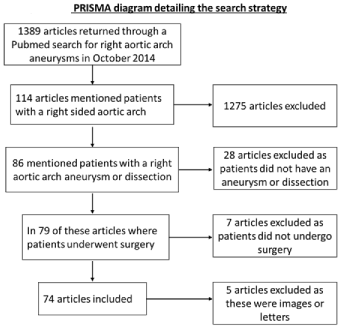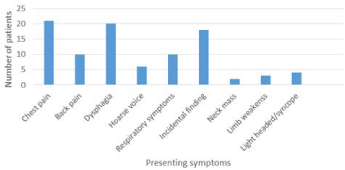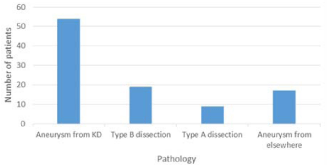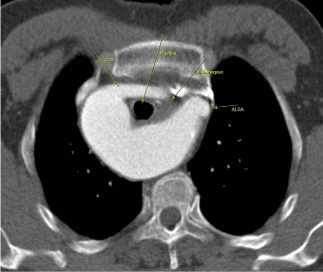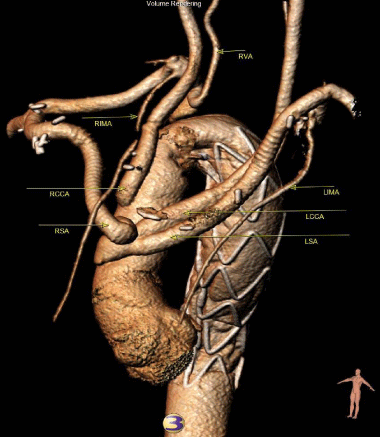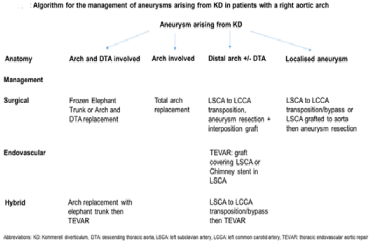Research Article
Surgical Management of Right Sided Aortic Arch Aneurysms
Barr JG1, Sepehripour AH2*, AJarral O2, Tsipas P3, Kokotsakis J3, Kourliouros A1 and Athanasiou T2
1Department of Cardiac Surgery, Harefield Hospital, UK
2Department of Cardiothoracic Surgery, Hammersmith Hospital, UK
3Department of Cardiothoracic Surgery, Evangelismos Hospital, Greece
*Corresponding author: Sepehripour AH, Department of Cardiothoracic Surgery, Imperial College Healthcare NHS Trust, Hammersmith Hospital, Du Cane Road, London W12 0HS, UK
Published: 31 Aug, 2016
Cite this article as: Barr JG, Sepehripour AH, AJarral O, Tsipas P, Kokotsakis J, Kourliouros A, et al. Surgical Management of Right Sided Aortic Arch Aneurysms. Clin Surg. 2016; 1: 1091.
Abstract
Aneurysms and dissections of the right sided aortic arch are rare and published data is limited to few case reports and small series. The optimal treatment strategy of this entity and the challenges
associated with their management are not yet fully investigated and conclusive. We performed a
systematic review of the literature to identify all patients who underwent surgical or endovascular
intervention for right aortic arch aneurysms or dissections. We focused on presentation and
critically assessed different management strategies and outcomes.
We identified 74 studies which reported 99 patients undergoing surgical or endovascular intervention
for a right aortic arch aneurysm or dissection. Median age was 61 years. The commonest presenting
symptoms were chest or back pain and dysphagia. 88 patients had an aberrant LSCA with only
11 patients having the mirror image variant of a right aortic arch. The commonest pathology was
aneurysm arising from a Kommerell’s diverticulum occurring in over 50% of the patients. 28 patients
had dissections, 19 of these were type B and 9 were type A. 81 patients had elective operations whilst
18 had emergency procedures. 67 patients underwent surgical treatment, 20 patients had hybrid
surgical and endovascular procedures and 12 had totally endovascular procedure. There were 5
deaths, 4 of which were in patients undergoing emergency surgery and none in the endovascular
repair group.
Aneurysms and dissections of a right sided aortic arch are rare. Advances in endovascular treatment
and as well hybrid surgical and endovascular management is making this rare pathology amenable
to these approaches and may confer improved outcomes compared to conventional extensive repair
techniques.
Keywords: Right sided aortic arch; Kommerell’s diverticulum; Aneurysm; Dissection
Introduction
A right sided aortic arch was first described 250 years ago by Fioratti and Aglietti [1]. It results from alterations in the normal embryonic development with regression of the left fourth arch or the
left dorsal aorta whilst the right dorsal aorta remains patent.
The commonest type of right sided aortic arch is the mirror image type where the first branch
of the aortic arch is the left branchiocephalic artery then the Right Common Carotid Artery (RCCA)
and finally the right subclavian artery (RSCA) [2]. The other main type of right sided aortic arch is
an aberrant left subclavian artery (LSCA) originating from the diverticulum of Kommerell which
is a remnant of the left arch. This can run posteriorly to the oesophagus 2. The branches originate
from the aortic arch in the following order: left common carotid artery (LCCA), RCCA, RSCA and
aberrant LSCA. If a left sided ligamentum arteriosum is present it will connect the left subclavian
artery to the left pulmonary artery which forms a vascular ring with the potential to compress
mediastinal structures [2].
A right sided aortic arch is found in 0.04–0.1% of autopsy studies [2]. There is an association
with 22q11 deletion hence aortic arch laterality and branching can be a part of a spectrum of other
cardiovascular anomalies [3]. Patients with right sided aortic arches are normally asymptomatic
however symptoms can occur either due to the aberrant anatomy of the right sided aortic arch
leading to compression of mediastinal structures or due to aneurysmal disease or dissection [4].
Compressive symptoms can lead to presentation, often in infancy,
of dysphagia as a result of oesophageal compression or respiratory
symptoms such as cough or stridor due to compression of the trachea
or bronchi.
Aneurysms of a right sided aortic arch are rare with reports being
limited to case reports and small case series. Aneurysmal disease
often originates from Kommerell’s Diverticulum (KD) resulting in
Kommerell’s aneurysmlocated at the origin of the aberrant LSCA. This
can also be a site for dissections to originate from [4]. Distinguishing
between a true KD which is an embryonic phenomenon and an
aneurysm arising from the origin of the aberrant LSCA is difficult
due to atherosclerotic changes affecting the artery 48.
Right sided aortic arch aneurysms and dissections span two
subspecialties of cardiac surgery. Right aortic arches are most
commonly seen by congenital surgeons in patients who require
surgery to relieve oesophageal or tracheal compression. However
aortic dissections and aneurysms are the remit of aortic surgeons.
Management of right sided aortic aneurysms requires knowledge
from both of these subspecialties to treat these complex pathologies.
Given the rarity as well as the heterogeneity of right aortic arch
aneurysms and dissections there has been no accepted gold standard
of treatment. Access to the right sided aortic arch is difficult [5]. Many
different surgical and more recently endovascular techniques have
been described.
We performed a systematic review of the literature to study all
patients who underwent surgical or endovascular intervention for
right aortic arch aneurysms or dissections. We focus on patient
presentation and management strategies for addressing the different
pathologies which bridge competencies from aortic and congenital
subspecialisation. Finally we report short term outcomes from
different management strategies.
Methods
Our search strategy was done in accordance with guidelines for the ‘Preferred Reporting Items for Systematic reviews and MetaAnalyses’ PRISMA [6]. We performed a PubMed search with the search criteriaright aortic arch aneurysms. Articles were reviewed and if the article reported patient (s) with a right sided aortic arch aneurysm or dissection that underwent surgery on the thoracic aorta then it was included and the full text was retrieved. Our search was restricted to articles published in English only. We performed the search in October 2014 and looked at all historical articles (Figure 1). We also reviewed the references of all relevant articles and reference lists of review articles. Patient characteristics and pathologies, different treatment modalities and outcomes where examined and critically analyzed.
Results
Reported studies and population characteristics
We identified 74 studies which reported 99 patients undergoing
surgical or endovascular intervention for a right aortic arch aneurysm
or dissection. Most studies were case reports with some case series
with the largest reporting 4 patients 13, 58.62 patients were male,
21 were female and for 16 patients the gender was not reported. The
median age at presentation was 61 years (range (21-85 years).
The commonest presenting symptoms were chest or back pain
in 31% (31 patients), dysphagia in 20% (20 patients), respiratory
symptoms such as cough, stridor or haemoptysis in 10% (10 patients).
18% of patients (18 patients) were asymptomatic and the finding was
incidental (Figure 2). The combination of dysphagia and cough are as
frequent as the ‘typical’ symptoms of aneurysms, therefore high level
of suspicion in this subgroup.
Diagnosis of a right sided aortic arch was most commonly made
with a chest radiograph which was then confirmed with computed
tomography.
88 patients had an aberrant LSCA with only 11 patients having
the mirror image variant. The commonest pathology was an
aneurysm arising from KD which occurred in 54 patients. 28 patients
had dissections, 18 of these were type B and 9 were type A (Figure
3). Some of these type B dissections originated from KD. Other
pathologies were aneurysms arising from elsewhere in the thoracic
aorta.
Interventional approaches
81 patients had elective operations whilst 18 had emergency
procedures. 67 patients underwent surgical treatment, 20 patients
had a hybrid surgical and endovascular procedures and 12 had a
totally endovascular procedure.
Of the hybrid procedures 6 patients had a total arch replacement
with an elephant trunk graft followed by a thoracic endovascular
aortic repair (TEVAR) with an endograft inserted into the elephant
trunk [7]. 5 patients had a frozen elephant trunk and 1 patient had a
modified elephant trunk. 8 patients had bypass procedures of the arch
vessels followed by a TEVAR procedure [8,9].
For the surgical group the commonest way of accessing the aorta
was via a median sternotomy or a right thoracotomy of the patients
with information on their incision 32 patients had a sternotomy, 4 of
whom had mini sternotomies. 22 patients had a right thoracotomy
this included one patient who had a double right thoracotomy
through the 4th and 7th intercostal spaces. Additionally 5 patients
had a combined median sternotomy and right thoracotomy. Other
incisions were a left thoracotomy (8 patients), left thoracotomy
and sternotomy (2 patients) bilateral thoracotomy (2 patients)
and left spiral thoracoabdominal incision (1 patient). For patients
undergoing hybrid procedure involving bypass of the arch vessels this
was achieved with J stick supraclavicular neck incisions.
In a group of 67 patients undergoing surgical treatment 64
patients were put on cardiopulmonary bypass (CPB) or partial CPB.
Circulatory arrest was needed in 37 of these patients.
Complications
The commonest complications reported were hoarse voice as a
result of injury to the recurrent laryngeal nerve (6 patients, 6%) and
respiratory complications (prolonged respiratory wean and chest
infection (7 patients, 7%)) (Table 1). There were 5 deaths, all of these
except 1 were in patients undergoing emergency surgery and none in
the endovascular repair group.
The first patient presented with a type B dissection and underwent
emergency surgery with an interposition graft performed via a right
thoracotomy. The LSCA was ligated. The patient never regained
consciousness and died 3 days post operatively [10].
The second patient presented acutely with haemoptysis and was
found to have fistula formation between a proximal right aortic arch
aneurysm and the right upper lobe of the lung. The patient underwent
emergency surgery and a knitted polyester patch (GelsealTM) closure
of the fistula was performed as well as an interposition graft for
an additional aneurysm of the DTA. He subsequently developed a
peri-graft abscess that ruptured into the oesophagus that resulted in
exsanguinations [11].
The third patient died of a massive pulmonary embolism after
undergoing elective LSCA to carotid transposition and interposition
graft to treat an aneurysm arising from KD [4].
The fourth patient presented acutely and was found to have
rupture of an aneurysm arising from KD. They underwent emergency
LSCA to RSCA bypass followed by total arch replacement. The cause
of death was reported as mediastinitis post operatively [14].
The last patient presented acutely with a type A dissection. Total
arch replacement was performed, however they were unable to resect
KD and so this was left. On post-operative day 30 the patient had
massive haematemesis leading to death. Post mortem examination
revealed a fistula between KD and the oesophagus [13].
Figure 1
Figure 2
Figure 3
Figure 3
Different pathologies affecting patients with a right sided aortic arch. KD: Kommerell diverticulum.
Table 1
Discussion
Our systematic review found 99 patients with right aortic arch
aneurysm or dissection, highlighting the rarity of this condition.
A higher proportion of patients were male and the median age of
presentation was 61 years old. Pain was the commonest presenting
symptom and was either felt in the chest, epigastrium or back.
Compression of the trachea, bronchi or the oesophagus leading to
respiratory symptoms or dysphagia, respectively, was responsible
for most of the other presentations. 89% of patients had an aberrant
LSCA and only 11% had a mirror image variant. This is differs from
pathological studies of the right aortic arch where 85% of patients
have the mirror image variant and 15% have an aberrant LSCA2.
This difference is likely the result of KD predisposing to aneurysm
formation as this area constitutes an area of weakness in the aortic
wall that is a potential area for aneurysmal dilatation and dissections
49. Additionally the median age at presentation was 61 years which
differs from patients with a left sided aortic arch in whom the median
age of presentation is about 65 years [14]. When there is a left sided
aortic arch it is the ascending aorta that accounts for about 70% of the
pathology [14]. These differences further highlight the significance of
KD on causing aortic pathology in a right sided arch.
CT was the commonest imaging modality for identifying right
aortic arch pathology. This is due to the availability of CT scanning as
well as the speed of scanning and high spatial resolution (Figure 4).
Magnetic Resonance Imaging (MRI) has also been used in assessing
aortic pathology in patients with right sided aortic arches. It has
the disadvantage of being less available than CT and the increased
time taken to obtain images excludes its use in emergency settings.
However it useful in assessing the pulsatile nature of tracheal and
oesophageal compression as well as the advantage of not using
ionising radiation. A case report from almost 20 years ago in a patient
with a type B dissection in a right aortic arch found that differentiation
between a dissection and an aortic aneurysm with mural thrombus
may be difficult on CT compared with MRI, however CT imaging has
improved greatly in that time [15].
The decision of when to operate on a patient with an aneurysm
arising from KD in patients with a right sided aortic arch is not straight
forwards. Clearly troublesome symptoms caused by compression of
mediastinal structures are an indication to intervene. Advising on
surgical intervention based on size is hampered by the paucity of data.
Balancing the risks of surgery against the risk of potential rupture if
left untreated is difficult. Some researchers have advised to intervene
when the diameter is greater than 3 cm whilst others recommended
5 cm as the point for intervention [4,16]. However rupture has
been described in aneurysms measuring as little as 2 cm [4]. In the
absence of significant comorbidities and with advent of less invasive
techniques it may be that the size threshold for aneurysms of the right
aortic arch is lower than the ones arising from the left.
The surgical or endovascular approach depends on the pathology
and site of the aorta affected. We discuss the approaches used
depending on the pathology.
Kommerell’s aneurysm
Aneurysms arising from KD were the commonest pathology,
occurring in 54% of patients (n=54. The treatment varied depending
upon the extent of the aneurysm.
For Kommerell’s aneurysms that involved the arch and
Descending Thoracic Aorta (DTA) repair could either be performed
as a single procedure or staged procedure. The frozen elephant
trunk graft, which has been described previously, allows this to be
performed as a single procedure (Figure 5). Idrees et al. [14] reported
doing this through a mini J sternotomy. The alternative is a 2 stage
procedure where the arch is replaced in the first instance with an
elephant trunk graft followed by either a TEVAR endograft inserted
into the elephant trunk8 or surgical replacement of the DTA via a
right thoracotomy [17].
For more localized aneurysmal dilatation of KD this could
be addressed by a number of surgical techniques. Options
included transposition of the LSCA to the LCCA followed by
endoaneurysmorrhaphy5 or ligation of the proximal and distal
ends of the aneurysm followed by bypass between the aorta and
LSCA with a synthetic graft [18]. All of the described approaches
persevered blood flow through the LSCA. Access was achieved via a
median sternotomy, right or left thoracotomy. These procedures were
performed either without bypass or with partial bypass from the left
atrium to the femoral artery or to the DTA. Left heart bypass allows
isolation of an aneurysm arising from KD as well as part of the aortic
arch and DTA. An aortic cross is placed between either the RCCA or
RSCA and the aneurysm as well as a cross clamp on the DTA distal to
the aneurysm. Cina et al. [4] used left heart bypass in 3 patients who
had aneurysms arising from KD with or without arch involvement and
required LSCA to LCCA transposition and endoaneurysmorrhaphy.
If a cross clamp can be placed between the aneurysm arising from KD
and the aorta then this could potentially treatment without bypass,
however if there is more extensive involvement of the arch then a
period of circulatory arrest is required.
When the aneurysm affected the arch then this could be addressed
either with a total arch replacement either by anastomosing all 4
branches separately to the graft [19], alternatively some surgeons
transposed the LSCA to the LCCA or RSCA first and then performed
total arch replacement [12]. All of these procedures were performed
via a median sternotomy.
When aneurysmal dilatation was more localised to the distal arch
+/- the DTA then this could be addressed with surgical, endovascular
or hybrid procedures.
Surgical options were LSCA to LCCA transposition followed by
resection of Kommerell’s aneurysm and the affected part of the aorta
followed by an interposition graft [20]. If the DTA was also affected
then this was also be replaced with a graft [20].
Endovascular options were TEVAR with the graft covering the
LSCA [21], as well as endovascularly occluding the LSCA prior to
TEVAR [22]. Alternatively to preserve flow through the LSCA the
aortic graft could be deployed along with another LSCA covered stent
directed parallel and extending more proximally to the main aortic
graft (Chimney stent) [23].Hybrid options depended on the extent that the aneurysm affected
the aortic arch. For aneurysms more localized around the LSCA these
could be treated with LSCA to LCCA bypass with ligation of the
proximal LSCA followed by TEVAR with the proximal land zone just
distal to the RSCA [8]. If the aneurysm extended towards the origin
of the RSCA then RSCA to RCCA and LSCA to LCCA bypass with
ligation of the proximal ends of both SCAs followed by TEVAR with
the proximal land just distal to the RCCA could be performed [9]. The
options for managing a patient with an aneurysm arising from KD are
shown in Figure 6.
Type B dissection
18 patients had a type B dissection. Type B dissections could
originate from distal or proximal to the LSCA. In some patients
KD was the area from which a tear occurred resulting in a type B
aortic dissection. Management can be surgical or endovascular.
Surgical options if the dissection originates distally to the LSCA are
with an interposition graft from the distal arch to the DTA [24]. If
the dissection was proximal to the LSCA then an interposition graft
between aorta just distal to the origin of the RSCA and DTA can be
placed. The LSCA can either be ligated [10] or an interposition graft
with a side branch that LSCA anastomoses to can be used to preserve
blood flow can be used [25]. These procedures were performed via a
right thoracotomy using CPB via the femoral artery and vein.
Endovascular treatment of type B dissection was performed in
6 patients and 3 of these patients had the mirror image variant. 3
patients had TEVAR procedures with an aortic stent alone whilst the
other 3 had an aortic stent followed by a Chimney stent. One patient
had the chimney stent for the RSCA into the aortic stent, one patient
and a Chimney stent deployed in the RCCA into the aortic stent with
no stent for the RSCA [26] and the final patient had chimney stents in
both the LSCA and RSCA [27].
Type A dissection
9 patients had a type A dissection. 8 of these presented acutely
and one was chronic [28]. Surgical strategies were similar to patients
with a type A dissection of a left sided aortic arch. They included:
aortic root replacement [29], interposition graft of the ascending
aorta [30], total arch replacement [31], total arch replacement with
elephant trunk and TEVAR into the elephant trunk [32] and frozen
elephant trunk [28]. There was one death in this group that has been
described above [13].
Descending thoracic aorta aneurysms
These were either managed surgically via a left thoracotomy
or right thoracotomy and placing an interposition graft under
circulatory arrest 19 or using left heart bypass [33] or endovascularly
with a TEVAR stent deployed distally to the LSCA [34].
Specific surgical considerations in right arch
Division of ligamentum arteriosum is required in all cases. The
right aortic arch can be retroesophageal where the right aortic arch
passes behind the trachea and oesophagus as opposed to the standard
configuration where it is in front of them [2]. This requires careful
mobilisation of the retroesophageal portion, an area which is often
less familiar for the general cardiac surgeon.
The means of accessing a right sided aortic arch depends on the
pathology being addressed. A right thoracotomy gives better access
to the right arch behind the oesophagus but hinders complex distal
arch and descending repair (where a left thoracotomy is the preferred
approach). Hybrid approaches allow for median sternotomy where
central bypass techniques can also be safely utilized.
Other cardiac anomalies are commoner in patients with a
right sided aortic arch. Focused echocardiography and coronary
angiography are required due to association with septal defects and
coronary anomalies (high take off of the RCA which is very relevant
in the case of type A dissection) [2,35].
Figure 4
Figure 4
CT images of a patient with a right-sided aortic arch with aberrant
left subclavian artery and aneurysm of the descending aorta highlighting who
the right sided aortic arch passes posterior to the trachea and oesophagus.
LCCA: left common carotid artery, ALSA: aberrant left subclavian artery.
Figure 5
Figure 5
Frozen elephant trunk repair of a descending thoracic aortic
aneurysm in a patient with a right sided aortic arch aneurysm performed by
our group.
RCCA: Right Common Carotid Artery; RSA: Right Subclavian Artery; LIMA:
Left Internal Mammary Artery; LCCA: Left Common Carotid Artery; LSA: Left
Subclavian Artery
Figure 6
Figure 6
Surgical treatment algorithm of patients with aneurysm originating from Kommerrel Diverticulum of patients with right aortic arch.
Limitations
Given the rarity of aneurysms and dissections of the right aortic arch the evidence is limited to case reports and small case series with short follow up. The lack of available long term data hinders to recommend what is the optimal approach for managing these pathologies.
Conclusion
Aneurysms and dissections of a right sided aortic arch are rare. The anatomy of the right sided aortic arch means that symptoms can be atypical for aneurysms as the predominant symptoms can be due to compression of the oesophagus or the airways. KD appears to be significant in causing aortic pathology in a right sided arch and is the reason for a younger age of presentation in patients with a right aortic arch. Advances in endovascular treatment and as well hybrid surgical and endovascular management is making more pathology amendable to these approaches and could reduce morbidity. Preoperative planning and careful delineation of anatomy and possible associated cardiac anomalies is essential.
References
- Fioratti F, Aglietti F. A case of human right aorta. Anatom Rec. 1763; 45: 365.
- Knight L, Edwards JE. Right aortic arch. Types and associated cardiac anomalies. Circulation. 1974; 50: 1047-1051.
- Marino B, Digilio MC, Toscano A, Anaclerio S, Giannotti A, Feltri C, et al. Anatomic patterns of conotruncal defects associated with deletion 22q11. Genet Med. 2001; 3: 45-48.
- Cinà CS, Althani H, Pasenau J, Abouzahr L. Kommerell's diverticulum and right-sided aortic arch: a cohort study and review of the literature. J Vasc Surg. 2004; 39: 131-139.
- Belov YV, Abugov SA, Komarov RN, Puretskiĭ MV, Stepanenko AB, Stogniĭ NY, et al. Hybrid surgical management of a patient with an aneurysm of the arch and descending portion of the right-sided aorta combined with type B dissection and decompensated tracheal stenosis. Angiol Sosud Khir. 2011; 17: 131-141.
- Moher D, Liberati A, Tetzlaff J, Altman DG, PRISMA Group. Preferred reporting items for systematic reviews and meta-analyses: the PRISMA statement. BMJ. 2009; 339: b2535.
- Kawajiri H, Shimizu H, Yoshitake A, Yozu R. Hybrid repair of a Kommerelln diverticulum associated with a right aortic arch and a left descending aorta. J Vasc Surg. 2012; 56: 1727-1730.
- Naoum JJ, Parenti JL, LeMaire SA, Coselli JS. Endovascular repair of a right-sided descending thoracic aortic aneurysm with a right-sided aortic arch andaberrant left subclavian artery. Ann Thorac Surg. 2008; 85: 1074-1076.
- Frigatti P, Grego F, Deriu GP, Lepidi S. Hybrid endovascular treatment of aneurysm degeneration in a rare right-aortic arch anomaly with Kommerell diverticulum. J Vasc Surg. 2009; 50: 903-906.
- Roan P, Parish S, Buja LM, Estrera A, Mills L, Atkins J, et al. Dissecting aortic aneurysm involving a right-sided aortic arch. Am J Cardiol. 1979; 44: 381-384.
- Matsuno O, Matsumoto T, Tsuda T. Aortic aneurysm involving a rightsided arch complicating aortobronchopulmonary and aortoesophageal fistula. Intern Med. 2001; 40: 722-725.
- Hosoba S, Suzuki T, Asai T, Nota H, Kuroyanagi S, Kinoshita T, et al. Surgical repair of Kommerell's diverticulum and an aberrant subclavian artery. Surg Today. 2014; 44: 247-251.
- Ota T, Okada K, Takanashi S, Yamamoto S, Okita Y. Surgical treatment for Kommerell's diverticulum. J Thorac Cardiovasc Surg. 2006; 131: 574-578.
- Idrees J, Keshavamurthy S, Subramanian S, Clair DG, Svensson LG, Roselli EE. Hybrid repair of Kommerell diverticulum. J Thorac Cardiovasc Surg. 2014; 147: 973-976.
- Thors A, Haurani MJ, Nelson KC, Crestanello JA. Aortic arch replacement through a left thoracotomy for right-sided aortic arch aneurysm with complete vascularring. Ann Thorac Surg. 2014; 97: 317-319.
- Maxwell BG, Harrington KB, Beygui RE, Oakes DA. Congenital anomalies of the aortic arch in acute type-A aortic dissection: implications for monitoring, perfusion strategy, and surgical repair. J Cardiothorac Vasc Anesth. 2014; 28: 467-472.
- Smith R, Attaran S, Field M, Oo A. Management of a chronic Stanford type B dissection in a patient with a right-sided aortic arch. Interact Cardiovasc Thorac Surg. 2011; 13: 523-525.
- Muraoka M, Uchiyama Y, Yamaoka N, Yamauchi H, Hashiyada H, Nakamura A, et al. An aberrant left subclavian artery aneurysm with right aortic arch: report of a case. Surg Today. 1999; 29: 675-678.
- Kai M, Okabayashi H, Soga Y, Hanyu M, Nomoto T, Nakano J, et al. Total arch replacement through a midsternotomy for a right-sided aortic arch aneurysm with an aberrant left subclavian artery. J Thorac Cardiovasc Surg. 2006; 132: 1473-1475.
- Robinson BL, Nadolny EM, Entrup MH, Svensson LG. Management of right-sided aortic arch aneurysms. Ann Thorac Surg. 2001; 72: 1764-1765.
- Midorikawa H, Kannno M, Ishikawa K, Takano T, Ono T, Morishima S. Endovascular Repair of a Kommerell's Diverticulum and Aneurysmal Right-sided Aortic Arch: A Case Report. Ann Vasc Dis. 2009; 2: 54-57.
- Monaco M, Lillo S, La Marca Giordano A, Contaldo A, Schiavone V. Endovascular repair of a right-sided thoracic aortic aneurysm with Kommerell diverticulum and aberrant left subclavian artery. Ann Vasc Surg. 2014; 28: 1323.e1-5.
- Silveira PG, Franklin RN, Cunha JR, Neves TT, Nascimento GG, Bortoluzzi CT. Total endovascular repair of aberrant left subclavian artery with Kommerell's diverticulum using a customized branched device. J Vasc Surg. 2013; 57: 1123-1125.
- Minato N, Rikitake K, Murayama J, Ohnishi H, Takarabe K. Surgery of the dissecting aneurysm involving a right aortic arch. J Cardiovasc Surg (Torino). 1999; 40: 121-125.
- Kim SY, Lee YS, Bae KR, Lee JB, Lee S, Kwon OC. A case of type B dissecting aneurysm involving right sided aorta with Kommerell's diverticulum. Korean J Intern Med. 2010; 25: 327-330.
- Ma H, Yang H, Xu W, Zou J, Jiang J, Jiao Y, et al. Endovascular repair with the chimney technique for Stanford type B aortic dissection involving right-sided arch with mirror image branching. J Endovasc Ther. 2013; 20: 283-288.
- Onohara T, Nakamura Y, Kishimoto Y, Harada S, Fujiwara Y, Saiki M, et al. Two cases of thoracic aortic aneurysm with right aortic arch: comparison of two operative strategies for hybrid thoracic endovascular repair. Ann Vasc Dis. 2014; 7: 343-346.
- Panduranga P, Al-Delamie T, Ratnam L, Al-Mukhaini M, Zachariah S. Repair of Kommerell's diverticulum with aberrant left subclavian artery in an elderly patient with right aortic archand dysphagia lusoria. J Card Surg. 2011; 26: 637-640.
- Tominaga R, Nishida T, Morita S, Masuda M, Yasui H. Atherosclerotic aneurysm in the circumflex retroesophageal right aortic arch. Ann Thorac Surg. 2001; 71: 2030-2032.
- Moizumi Y, Komatsu T, Nagaya K, Sawamura Y, Sakurai M, Tabayashi K. Type A aortic dissection involving a right-sided aortic arch. J Cardiovasc Surg (Torino). 1999; 40: 117-119.
- Hori D, Tanaka M, Yamaguchi A, Adachi H. Type A aortic dissection, right-sided aortic arch, and thoracic aortic aneurysm. Asian Cardiovasc Thorac Ann. 2009; 17: 640-642.
- Croccia MG, Levantino M, Cioni R, Bortolotti U. Endovascular stenting for type B dissection involving a right-sided aortic arch. Interact Cardiovasc Thorac Surg. 2012; 15: 304-306.
- Agostini M, Priotto R, Feola M, Losardo L, Grosso M, Grossi C. Surgical treatment of an aneurysm originating from a Kommerell's diverticulum in the right-sided aortic arch with retroesophageal component. Ital Heart J. 2005; 6: 977-980.
- Klonaris C, Avgerinos ED, Katsargyris A, Matthaiou A, Georgopoulos S, Psarros V, et al. Endovascular repair of a right-sided descending thoracic aortic aneurysm associated with a right aortic arch and a left subclavian artery arising from a Kommerell's diverticulum. Cardiovasc Intervent Radiol. 2009; 32: 758-761.
- Hu Y, Li Z, Chen J, Zhong Q. High takeoff of the right coronary artery associated with ventricular septal defect, right aortic arch, and bridging bronchus. J Card Surg. 2014; 29: 829-831.

